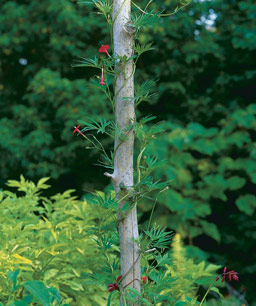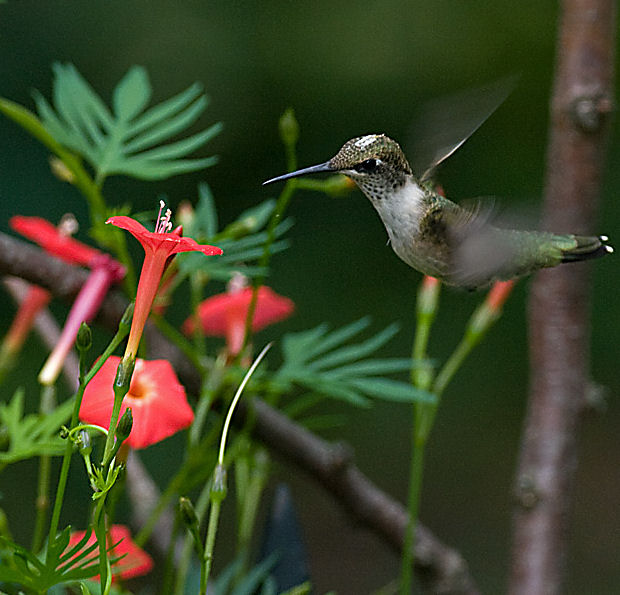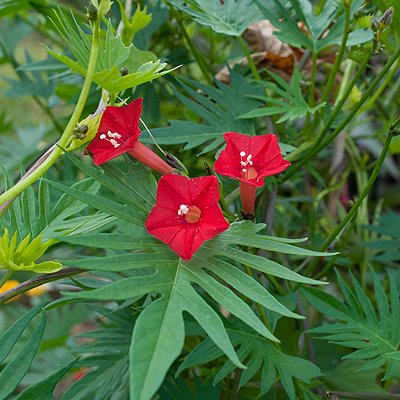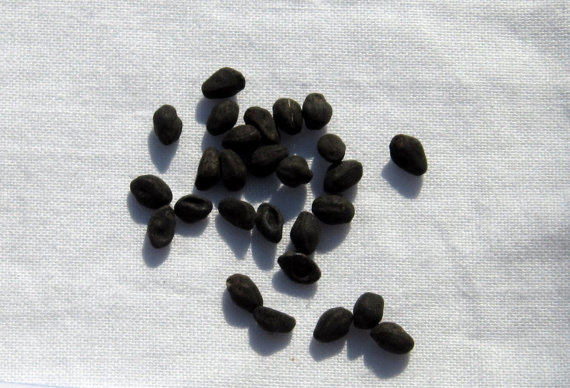 Download PDF
Download PDF
Name: Ipomoea x multifida (Raf.) Shinners
Family: Convolvulaceae, the bindweed or morning glory family
Common Names: Cardinal climber, morning glory, hearts and honey vine, cypress vine (5,8,17).
Etymology: The genus name Ipomoea is from the Greek ips, which means “a worm,” and homoios which, means “resembling,” referring to the wormlike twining habit. The letter “x” before the species name means “hybrid”, and multifida in Latin means “splintered”, probably referring to the deeply lobed leaves (1,6).
 Botanical synonyms (5,11,15):
Botanical synonyms (5,11,15):
Quamoclit multifida Raf.
Quamoclit x sloteri (Nieuw.) House
Ipomoea x sloteri (Nieuw.) Ooststr.
Quick Notable Features (11,12):
¬ Twining vine with alternate, simple, deeply lobed leaves
¬ Each leaf has 3-7 pairs of narrow-lanceolate lobes
¬ Flowers are tubular, scarlet red, with a yellowish to white throat
¬ Fruit is an ovoid capsule bearing < 4 dark, tufted seeds
Plant Height: The cardinal climber grows up to 6-7m tall (12,18).
Subspecies/varieties recognized: none found.
 Most Likely Confused with: Ipomoea pandurata, I. hederacea, I. purpurea, Citrullus lanatus.
Most Likely Confused with: Ipomoea pandurata, I. hederacea, I. purpurea, Citrullus lanatus.
Habitat Preference: The cardinal climber prefers dry to moist, well-drained soils with full sun exposure (3).
Geographic Distribution in Michigan: I. x multifida was collected in Jackson Co., escaped from cultivation (8).
Known Elevational Distribution: No information was found.
Complete Geographic Distribution: The cardinal climber was developed as a hybrid in the United States and thus has no natural range. It is only found escaped from cultivation in Texas, Florida, and Michigan (2). The hybrid is cultivated ornamentally throughout the world (11).
Vegetative Plant Description: The stems of the annual cardinal climber are glabrous with linear ridges. The stipules are 0.5-2 mm long, and the petioles are 1-3cm long. The simple, alternate leaves are glabrous, 2-12.7cm long and 2.5-5.5cm broad (or slight broader in leaves longer than 5cm) with 3-7 pairs of narrowly lanceolate, deep, pinnate lobes, and one terminal lobe that is the broadest; the sinuses reach 2/3-3/4 of the way to the midrib or base of the segments. Each leaf is broadly ovate to oblong, and pinnately veined (8,10,11,12,20,21).
Climbing Mechanism: Stem twining (3,12,17), with a dextrally oriented direction (see habit image).
 Flower Description: The cymose inflorescence is composed of 1-5 perfect actinomorphic flowers. The peduncles are 4-8.5cm long. The calyx has 5 elliptic to oblong sepals that are apically obtuse with long appendages, glabrous, and 0.6-0.8cm long. I. x multifida has a salverform corolla that is 4-5cm long and 2.5cm broad, scarlet red with yellow or white in the tube. The 5 epipetalous stamens are exserted well beyond the tube, and are about 2.3cm long. The bi-carpellate ovary is superior with 4 ovules. The single filiform style is exserted from the tube and topped with a 1 to 2-lobed, globular stigma. The hypogynous disk produces nectar (8,10,11,12,19,20).
Flower Description: The cymose inflorescence is composed of 1-5 perfect actinomorphic flowers. The peduncles are 4-8.5cm long. The calyx has 5 elliptic to oblong sepals that are apically obtuse with long appendages, glabrous, and 0.6-0.8cm long. I. x multifida has a salverform corolla that is 4-5cm long and 2.5cm broad, scarlet red with yellow or white in the tube. The 5 epipetalous stamens are exserted well beyond the tube, and are about 2.3cm long. The bi-carpellate ovary is superior with 4 ovules. The single filiform style is exserted from the tube and topped with a 1 to 2-lobed, globular stigma. The hypogynous disk produces nectar (8,10,11,12,19,20).
Flowering Time: I. x multifida flowers from June-September in Illinois (3).
Pollinator: The cardinal climber is autogamous (11,14) but attracts hummingbirds and butterflies that may serve as pollinators (12).
 Fruit Type and Description: I. x multifida bears an ovoid capsule 0.7-0.9cm in length (11).
Fruit Type and Description: I. x multifida bears an ovoid capsule 0.7-0.9cm in length (11).
Seed Description: The seeds are dark brown to black, hard, and glabrous or with tufts of short pubescence. Seeds must be scarred or soaked in water prior to sowing to germinate (3,11).
Dispersal Syndrome: No dispersal method was found in the literature, but the species is likely dispersed by humans in trade, as it is treasured for its flowers.
Distinguished by: No other species of Ipomoea in Michigan has a) leaves that are deeply and narrowly lobed, b) red salverform corollas with long exserted stamens and c) exserted style and stigma. Ipomoea pandurata has cordate-ovate leaves and white flowers with purple in the tube. I. hederacea and I. purpurea have pubescent (not glabrous) stems. I. hederacea has 3-lobed leaves and blue to purple flowers. I. purpurea has cordate, unlobed leaves, with a white, pink, purple or bluish corolla. Citrullus lanatus also has alternate, deeply pinnately lobed leaves; however it is usually a creeping vine that climbs using its tendrils, unlike the apical twiner I. x multifida. Further, the whole plant is covered in hairs, the yellow flowers are solitary and unisexual, and the fruit is a large berry commonly known as watermelon (8,16,22).
Other members of the family in Michigan (number species): Calystegia (5), Convolvulus (1), Cuscuta (9), and Ipomoea (4) (source 8).
Ethnobotanical Uses: The plant is used worldwide as an ornamental plant (11). As a hybrid created by humans and cultivated for ornamental purposes (13), it does not have ethnobotanical history beyond its floral attractiveness in gardens. The seeds are toxic (10).
Phylogenetic Information: The Convolvulaceae is a member of the order Solanales. Solanales forms a monophyletic group with Lamiales and belongs to the Asterid I clade. Within Convolvulaceae there are two groups: Humbertioideae, the rare large trees, and Convolvuloideae, comprising both woody and herbaceous vines. Edible and ornamental members of this family are found worldwide, with the exception of polar regions and deserts of Patagonia, Sahara, and Taklimaka (4).
Interesting Quotation or Other Interesting Factoid not inserted above: I. x multifida is a hybrid of I. coccinea and I. quamoclit created by L. Sloter. It took 11 years of crossing to create one successful seed that became the source of all cultivated I. x multifida (8,13). If ingested, the seeds of several Ipomoea species are poisonous to humans and livestock (7). Symptoms include: hallucinations, dilated pupils, nausea, vomiting, diarrhea, drowsiness, numbness of extremities, and muscle tightness upon ingestion (9). Species of Ipomoea are considered noxious weeds in Arkansas and Arizona, where the genus is prohibited (2). A few problems that may afflict cultivated I. x multifida are “white blister, rust, fungal leaf spots, stem rot, thread blight, charcoal rot, and wilt” (10).
Literature and websites used:
- Mahoney, K. 2002-2013. Latdic. http://www.latin-dictionary.net/definition/27371/multifidus-multifida-multifidum
- USDA, NRCS. 2013. The PLANTS Database (http://plants.usda.gov, 02/27/2013). National Plant Data Team, Greensboro, NC 27401-4901 USA.
- University of Illinois Extension – Hortanswers: Cardinal Climber. http://urbanext.illinois.edu/hortanswers/plantdetail.cfm?PlantID=528&PlantTypeID=5
- Stevens, P.F. Angiosperm Phylogeny Website. Version 7, May 2006. http://www.mobot.org/MOBOT/research/APweb
- ITIS: Integrated Taxonomic Information System http://www.itis.gov/index.html. Accessed 27 February 2013.
- Stearn, W.T. 1992. Stearn’s Dictionary of Plant Names for Gardeners. London: Cassel Publishers Limited.
- Ohio Perennial and Biennial Weed Guide. Bigroot Morningglory. http://www.oardc.ohio-state.edu/weedguide/singlerecord.asp?id=640 (02/27/2013).
- Michigan Flora Online. A.A. Reznicek, E.G. Voss, & B.S. Walters February 2011. University of Michigan. Web. February 27, 2013. http://michiganflora.net/species.aspx?id=862.
- Evergreen Native Plant Database 2000-2011. Plant Detail: Ipomoea pandurata. http://nativeplants.evergreen.ca/search/view-plant.php?ID=05333 (02/27/2013).
- Fine Gardening 2013. Ipomoea x multifida (cardinal climber). The Tauton Press, Inc. http://www.finegardening.com/plantguide/ipomoea-x-multifida-cardinal-climber.aspx
- Austin, D.F. 2011. Flora of Pakistan: Ipomoea x multifida. http://www.efloras.org/florataxon.aspx?flora_id=5&taxon_id=250096946
- Appell, S.D. 2003. Annuals for Every Garden, Issue 174. Brooklyn, NY: Brooklyn Botanic Garden.
- Brown, B.P. & J.E. Eckenwalder 1983. The origin of the cardinal climber, Ipomoea x multifida (Raf.) Shinn. Amer. J. Bot. 70, Part 2(5): 107.
- McGregor R.L. 1986. Flora of the Great Plains. Lawrence, KS: The University Press of Kansas.
- Tropicos.org. Missouri Botanical Garden. 27 Feb 2013 <http://www.tropicos.org/Name/8500731>
- Fernald, M.L. 1950. Gray’s Manual of Botany, 8th ed. New York: American Book Company.
- Evans, E. Vines for the Southeast Plant Fact Sheets. NC State University. http://www.ces.ncsu.edu/depts/hort/consumer/factsheets/vines/ipomoeax_multifida.html
- Coulter, L. 2009. Gardening with Heirloom Seeds. Reed Elsevier: London, England, UK.
- Zomlefer, W.B. 1994. Guide to Flowering Plant Families. Chapel Hill, NC: The University of North Carolina.
- Carmen & Bernard Horne, Herbarium Collection Number 4. August, 1957. University of Michigan Herbarium (MICH).
- Nieuwland, J.A. 1915 Quamoclit Sloteri. American Midland Naturalist 4(3): 71-74.
- Lu, A. & C. Jeffrey 2011. Flora of China, Vol. 19: 1. Cucurbitaceae. http://www.efloras.org/florataxon.aspx?flora_id=2&taxon_id=200022609
Image Credits (all used with permission):
1) Image of habit courtesy of Lee Anne White – Reprinted with permission © 2013 The Tauton Press, Inc. finegardening.com/plantguide
2) Image of flower and hummingbird courtesy of Bud Hensley via Botanical Interests, http://www.flickr.com/photos/botanicalinterests/3448776138/sizes/m/in/photostream/
3) Image of flowers © Select Seeds, at http://www.selectseeds.com/
4) Image of seeds © Annie Andreoni of Etsybtsy at http://www.etsy.com/listing/81945911/cardinal-climber-ipomoea-x-multifida?show_panel=true
Primary Authors: Cristine V. Santanna with revisions and editing by Robyn J. Burnham.
© Robyn J. Burnham
For additional information on Michigan Plant Diversity species accounts, please contact Robyn J. Burnham via email: rburnham“at”umich.edu